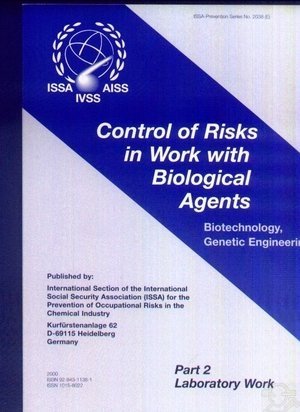Control of Risks in Work with Biological Agents
İÇİNDEKİLERContents1. Introduction 2. Biological agents and their risks to humans 2.1 Biological agents 2.2 Infectivity 2.3 Pathogenicity and virulence 2.4 Ability to form toxins 2.5 Allergenicity 3. Transmission of infectious agents - chain of transmission and reservoirs 4. Defence against infection 4.1 Immunological defences 4.1.1 Immune status 4.1.2 General state of health 4.2 Immunity and vaccination 5. Assessment of risks before the use of biological agents 5.1 Risk Group 1 5.2 Risk Group 2 5.3 Risk Group 3 5.4 Risk Group 4 6. Dispersal mechanisms 6.1 The air-borne route 6.1.1 Aerosols 6.1.2 Mechanisms of aerosol formation 6.2 Dispersion by human agency 7. Safety in the laboratory 7.1 General principles concerning the control of risks 7.2 Laboratory equipment 7.3 Some general rules concerning laboratory work 7.4 Working with biological agents at Containment Level 1: General rules applicable to the use of biological agents 7.5 Working with biological agents at Containment Level 2 7.6 Working with biological agents at Containment Level 3 7.7 Working with biological agents at Containment Level 4 8. Safe use of laboratory equipment 8.1 Centrifuges 8.2 Autoclaves 8.3 Equipment for cell disruption 8.4 Blenders (Vortex mixers, shakers) 8.5 Fermenters and other apparatus 9. Microbiological safety cabinets (MSCs) 9.1 Classification of MSCs 9.2 General guidelines for class 1. 2 and 3 MSCs 9.3 Additional guidelines for class 1 and 2 MSCs 9.4 Additional special guidelines for class 2 MSCs 9.5 Additional guidelines for class 3 MSCs 9.6 Testing MSCs 10. Disinfection and sterilisation 10.1 Physical methods 10.1.1 Moist heat 10.1.2 Dry heat 10.1.3 Filter sterilisation of gases and liquids 10.1.4 Ultraviolet radiation (UV) 10.2 Chemical methods 10.2.1 Overview and criteria for choice 10.2.2 Examples of common disinfectants 10.2.3 Precautions in the use of chemical disinfectants 11. Cleaning laboratories and hygiene protocol 11.1 Cleaning laboratories 11.2 Hygiene protocol 12. Monitoring of cleaning and disinfection measures (biocontrol programme) 12.1 Surfaces 12.2 Air quality control 13. Chemical risks 13.1 Types of risks 13.2 Some general guidelines 13.3 Examples of dangerous chemical substances 14. Other risks 14.1 Fire and explosion 14.2 Mechanical risks 14.3 Pressurised gas cylinders 14.4 Electricity 14.5 Burns and scalds 14.6 Cryogenic substances 14.6.1 Liquid nitrogen 14.6.2 Dry ice (solid CO2) 14.7 Risks at work with lasers 14.8 Ultraviolet radiation (UV) 14.9 Radioactivity 14.10 Ultrasonics 15. Emergency measures 16. Occupational health surveillance 17. Check list befor commencing work with biological agents Annex: Cell cultures Further literature NOTLARBiotechnology, Genetic Engineering-Laboratory Work   |



